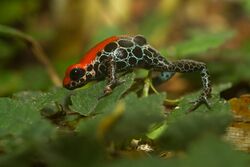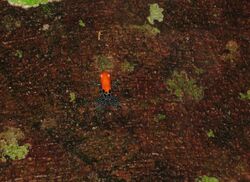Biology:Red-backed poison frog
| Red-backed poison frog | |
|---|---|

| |
| Scientific classification | |
| Domain: | Eukaryota |
| Kingdom: | Animalia |
| Phylum: | Chordata |
| Class: | Amphibia |
| Order: | Anura |
| Family: | Dendrobatidae |
| Genus: | Ranitomeya |
| Species: | R. reticulata
|
| Binomial name | |
| Ranitomeya reticulata (Boulenger 1884)
| |
| Synonyms | |
| |
The red-backed poison frog (Ranitomeya reticulata)[1] is a species of frog in the family Dendrobatidae. It is an arboreal insectivorous species, and is the second-most poisonous species in the genus, after R. variabilis. Like many species of small, poisonous frogs native to South America, it is grouped with the poison dart frogs, and is a moderately toxic species, containing poison capable of causing serious injury to humans, and death in animals such as chickens. R. reticulata is native to the Amazon rainforest in Peru and Ecuador.[1]
Poison
The red-backed poison frog is a moderately toxic dendrobatid, and is the second-most poisonous of the frogs in the genus Ranitomeya. Its toxins are used as the frog's natural defense mechanisms, making them inedible to many, if not most, of the predators in its natural area. To advertise its poison and further reduce the risk of injury, the red-backed poison frog displays its brilliant warning colors, especially its red-orange back, for which it is named. Like all dendrobatids, it does not manufacture its poison itself, but rather is theorized to take the toxins from the ants, mites, and beetles on which it lives. It absorbs the insects' poisons into its body, which is immune to the poison. The poison is stored in skin glands just beneath the frog's epidermis. The poison seeps through open wounds and orifices, and, it is believed, through the pores. This defense is especially effective against mammalian and avian predators, and, to a lesser extent, reptilian ones. Amazonian ground snakes have a limited resistance to the poison, and occasionally will attack such frogs.
Description
Ranitomeya reticulata is one of the smaller species of poison dart frogs, hence its inclusion in the "thumbnail" species group. Males can reach approximately 12 mm in length from snout to vent, while the larger females may reach 15 or even 20 mm long. Like all poison dart frogs, R. reticulata are vividly coloured and patterned, which advertises their poison. Red-backed poison dart frogs have black legs with a cobalt or sky-blue mesh pattern, a black belly, and a back that ranges from fiery orange to scarlet in color, hence the common name. Like all arboreal frogs, R. reticulata possess suckerlike disks on their toes which makes their grip adhesive. As they are very small, they often attempt to advertise their poison by flaunting such colors or by ascending trees to escape from predators. If isolated from any form of escape, R. reticulata will use their poison as a defense mechanism. R. reticulata are more slimly built than many dendrobatids, which combined with their small size, gives them the ability to squeeze into minute hiding places.
Reproduction
R. reticulata naturally live in groups of five or six. At the end of the wet season, several of these groups join in large breeding gatherings. As with other poison dart frogs, the males court the females by calling to capture their attention, and then by gently stroking and licking them. A female will signal that she is sufficiently impressed by stamping her hind feet. The two frogs will then mate. The fact that the breeding season begins at the end of the wet season ensures that the eggs will be laid at the beginning of the next wet season, ensuring that the young will have a steady supply of water to keep them alive. Once the eggs hatch, the male carries the baby tadpoles into the canopy. The tadpoles have a water-soluble adhesive mucus that helps them stick to their father's back. The male R. reticulata will deposit the tadpoles into the tiny pools that accumulate in the centre of bromeliads. The female will then feed the tadpoles with infertile eggs that she lays into the water. Once the tadpoles become froglets, they are led by their parents to an existing group of red-backed poison frogs [citation needed]. While the young froglets are accepted by all members of the group, only their parents will look after the young frogs [citation needed].
As pets
R. reticulata is considered a species for advanced dart hobbyists only. Their small size, breeding difficulties, and generally difficult care relative to other darts shows through high mortality rates with novice keepers. These difficulties are also the reason that the frog is fairly uncommon in the dart frog hobby and command a price upwards of $125–150 U.S. dollars per frog. It is also recommended to only keep them in pairs unless the tank size is substantial (55 gallons or larger), as there are many witness accounts and anecdotal reports of heavy same-sex aggression in smaller enclosures.
See also
References
- ↑ 1.0 1.1 Icochea, J., et al. 2004. Ranitomeya reticulata. In: IUCN 2012. IUCN Red List of Threatened Species. Version 2012.2. Downloaded on 31 May 2013.
Wikidata ☰ Q3418982 entry
 |



